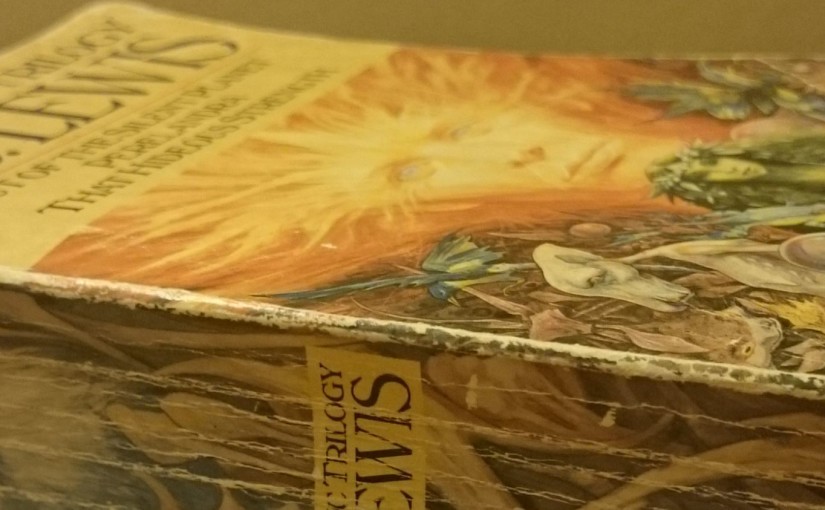I’ve just had the pleasure of (re)reading Perelandra with my wife – it’s her first time, but one of many times I’ve read it. It’s possibly my favourite C S Lewis novel (against strong competition!). I first read it back when I was in secondary school, and it made a deep and lasting impression on my thinking and imagination.
Perelandra sees Cambridge philologist Dr Elwin Ransom dispatched on a divine mission to Venus (or Perelandra as it is known, hence the title), where he must prevent the Green Lady, the Eve of that planet, from falling to temptation and casting that world into misery like our own. It’s the sequel to C. S. Lewis’s earlier science fiction novel Out of the Silent Planet, which describes how Ransom was kidnapped and taken to Mars, known as Malacandra, where he learned Old High Solar and discovered that the heavens are filled with angelic beings called eldila, and that Earth is under spiritual siege in the cosmos.
Like all of C S Lewis’s fiction, it’s not without its detractors. It is very explicitly driven by ideas in a way that’s quite unfashionable for the modern novel, where ambiguity and unresolved tensions are highly valued. Lewis was a master essayist, and the way he tackles his themes is very direct and on the surface. You could argue that the characters in Perelandra merely parrot their lines to articulate the views of the author, as if it were only a very elaborate sermon illustration or philosophical dialogue.
But this seems to me unfair: while large parts of Perelandra are very talky in a way that is quite stagey, it is far more than just that. Although theological and philosophical questions loom large in the novel, one of the aspects that sticks with me most vividly is the solidity and particularity of the physical and psychological detail. Lewis’s descriptive powers are given full muscle on the many occasions Ransom experiences things that he doesn’t yet understand. When Ransom first arrives on Perelandra, we have described through his eyes those first few seconds of incomprehension as the landscape rolls around him, hills rushing towards him, before he realises that he has landed in an ocean. It’s a trick that Lewis uses again and again, as this newborn world is made fresh and vivid in its sights and smells and tastes.
Central to the novel is the debate between the Green Lady (the Eve-figure of Venus), the Un-man (formerly the brilliant but ruthless Wellsian scientist Professor Weston, now demonically possessed and acting as tempter) and Ransom, the novel’s unlikely hero. But while the back and forth between them is a clear and powerful argument about the merits of obedience versus rebellion, the relationship between wisdom and innocence (anticipating by a good fifty years in the voice of the Un-man Philip Pullman’s treatment of these themes in His Dark Materials), the conversation is far from abstract. The same insight into human nature that underpins The Screwtape Letters makes Lewis’s depiction of the temptation of the innocent, un-Fallen Green Lady a fascinating psychological study. Later, when Ransom realises that the Green Lady has resisted long enough, and it falls to him to defeat the Un-man in physical struggle, Lewis describes his inner conflict with the realism of a man who fought in the First World War, made recognisable to anyone who has struggled to face an unpleasant and unavoidable task.
Besides Perelandra‘s very earthy, embodied qualities, science fiction is very often ideas-driven, and to say that novels must always be oblique in their themes is needlessly prescriptive. I think part of the issue is that Perelandra stands out as odd within its field simply for taking an explicitly Christian universe as given, and developing its ideas of extraterrestrial life on that basis. The science fiction element is not simply a peg for Lewis to hang an allegory on; the situation of preventing a second Fall on Perelandra is a very valid “supposal” of what might occur on another world on the basis of a Christian worldview.
The disjunct with the wider science fiction genre goes further than that, though – Lewis goes out of his way to rebut a naturalistic view of the universe as vast, cold and uncaring, setting out a spiritual vision of the universe as a Great Dance of life and meaning, upsetting many of the assumptions often taken for granted in science fiction. For readers who don’t share Lewis’s Christian faith, it requires a double “suspension of disbelief”, not only in terms of the story itself, but also of the Christianity it presupposes. But while I can understand that the Christian underpinning makes it less accessible to many, I don’t think this diminishes its literary qualities. Lewis skilfully and compelling weaves his story and its vision of a “meaning-drenched universe”, to borrow a phrase from Michael Ward, author of Planet Narnia. It might not qualify as a good science fiction novel in conventional terms, but on its own terms as a planetary romance it’s a brilliant and vivid piece of writing.

